24 Food Additives That You Should Consider Avoiding
Introduction
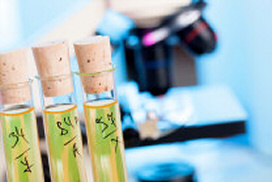 Thousands of food additives are permitted for use in food manufacturing in U.S.
Additives can be used for a variety of reasons. Not only are they included to
enhance flavor or maintain a food’s coloring, but they may be used to ensure a long
shelf life as well. Although the additives listed below have received FDA (Food
and Drug Administration) approval, they still can negatively impact one’s
health. Thousands of food additives are permitted for use in food manufacturing in U.S.
Additives can be used for a variety of reasons. Not only are they included to
enhance flavor or maintain a food’s coloring, but they may be used to ensure a long
shelf life as well. Although the additives listed below have received FDA (Food
and Drug Administration) approval, they still can negatively impact one’s
health.
Adverse health reactions can include hives, upset stomach, headache, or
fatigue. According to research, approximately 1% of adults and 2% of children
are affected by the substances.
24) Castoreum
|
Wild Beaver:
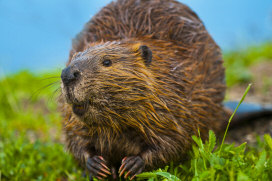
|
What is It?
Castoreum is extracted from the anal scent glands of beavers.
Castoreum is used in food manufacturing to give food a musky taste.
Where is it Found?
Castoreum is commonly found in raspberry and vanilla flavored products. Legally,
food makers can list the product simply and deceptively as a “natural
ingredient.”
Why You Should Avoid It
While you can take comfort in the fact that Castoreum isn’t harmful, it is
still one ingredient you’ll want to avoid. The ingredient is derived from the anal
scent glands of the beaver, and therefore is used, in the wild, to mark the
animal’s territory.
23) Olestra
|
Studies Show Olestra Can Lead to Anal
Leakage:

|
What is It?
In a world largely obsessed with weight and health, olestra seemed like the
perfect food additive when it was approved by the FDA and released in 1996. When
the ingredient is added to diet foods, it’s supposed to keep dieters from
absorbing fat.
Where is it Found?
Olestra is commonly found in diet junk foods, such as fat free potato chips.
Why You Should Avoid It
While olestra stops the body from absorbing fat, it also affects a person’s
ability to absorb vitamins. So both the fat and nutrients of a food are flushed
from a person’s system. Side effects range from gas, cramps to leakage of the
bowels. Nevertheless, the FDA has opted to leave olestra on the market and allow
consumers to make up their mind as to whether or not eating foods containing the
additive is worth the possible consequences.
22) Tartrazine/Yellow
#5
|
Boxed Macaroni and Cheese Contains Yellow
#5:
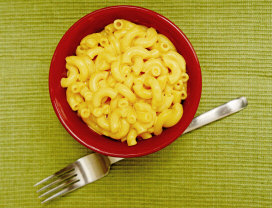
|
What is It?
Tartrazine, otherwise known as FD&C Yellow #5, is suspected of causing many
reactions, including asthma, hives and various other health concerns.
Where is it Found?
Tatrazine is generally included in candies and other types of sweets.
Why You Should Avoid It
While it was once believed that asthmatics, who were allergic to aspirin, would
react negatively to tartrazine, recent studies have disproved the theory.
According to research, tatrazine is linked with breathing difficulties and skin
eruptions, including atopic dermatitis.
21) Sodium
benzoate
|
Sodium Benzoate
is in Some Sugary Store-bought Juices:
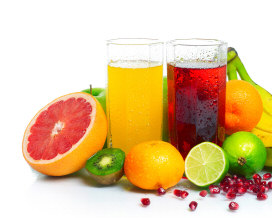
|
What is It?
Sodium benzoate causes a tingling sensation in your throat when you drink a
soda.
Where is it Found?
Sodium benzoate can be found in most carbonated drinks, fruit juices, salad
dressings, jams, condiments and pickles.
Why You Should Avoid It
While the FDA considers the product safe, a study conducted in 2007 showed that
a combination of sodium benzoate and food dyes could be linked to hyperactivity
in kids.
20) Sunset
Yellow FCF/Artificial Yellow 6
|
Sunset Yellow FCF
is Contained in Some Energy:
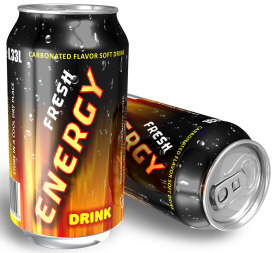
|
What is It?
Sunset Yellow FCF, otherwise known as Artificial Yellow 6, is a food coloring.
Where is it Found?
Artificial Yellow 6 can be found in a number of beverages, baked goods, gelatin
desserts, candy and sausages.
Why You Should Avoid It
Studies supported by the food industry tested the color additive on animals and
unearthed evidence that suggests that Sunset Yellow FCF has been linked to
allergic reactions and tumors in the kidneys and adrenal glands. It is one of
the most commonly used food dyes.
19) Bisphenol A
(BPA)
|
BPA Promotes the Growth, Invasiveness,
and Metastasis of Cells:
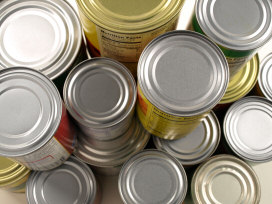
|
What is It?
While the chemical bisphenol A, otherwise known as BPA, is generally no longer
used to produce items made of hard plastics, it still is frequently used in the
lining of canned goods. Although it isn’t technically an additive, BPA, when
included in cans, can still seep into the food, especially if the food is
acidic.
Where is it Found?
The inner linings of cans used to hold canned foods contain BPA.
Why You Should Avoid It
BPA has been linked to developmental problems in fetuses and children.
Therefore, it’s best to steer clear of any food product that comes in a can,
unless it specifically states that the lining of the container is BPA-free.
18) Carmine
|
Carmine - Food Dye From Insects:
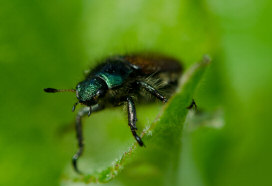
|
What is It?
Carmine is a red food dye that comes from insects. Specifically, it comes from
boiled cochineal bugs.
Where is it Found?
Carmine is commonly found in a variety of candies, ice creams, lemonades and
grapefruit juices.
Why You Should Avoid It
Studies have found that carmine can trigger serious allergic reactions in some
people, even life-threatening anaphylactic reactions. The FDA requires that the
additive needs to be clearly listed among the ingredients in food and cosmetic
products.
|
The Popular Candy Smarties Contain
Brilliant Blue:
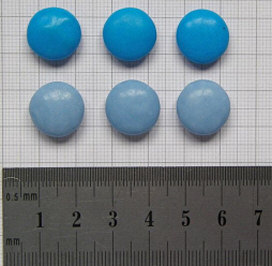
|
17) Brilliant Blue
FCFC/Artificial Blue #1
What is It?
Brilliant Blue FCFC, otherwise known as Artificial Blue #1, is an artificial
coloring.
Where is it Found?
Artificial Blue is found in candies, baked goods and drinks.
Why You Should Avoid It
While there is no strong evidence to link the additive with cancer, there is
some evidence to suggest a risk exists. General testing of Artificial Blue has,
so far, been inconclusive.
16) Aspartame
|
Many Hard Candies Contain Aspartame as
Well as Diet Sodas
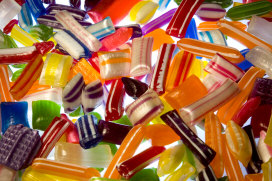
|
What is It?
Aspartame is an artificial sweetener.
Where is it Found?
Aspartame is found in a variety of “sugar free” products, specifically diet
foods like soft drinks and frozen desserts.
Why You Should Avoid It
Since the 1970s, there have been conflicting opinions with respect to the safety
of the product. Initial studies on rats, found that there may be a link to brain
tumors. Recent studies have also linked aspartame to leukemia, lymphomas and
breast cancer. Some people have also been found to be highly sensitive to the
product, suffering dizziness and headaches. In addition, studies show that
aspartame, which is used as a diet aid, can actually cause people to eat more.
15) Caramel
Coloring
|
Caramel Coloring is Used to Flavor
Coca-Cola:
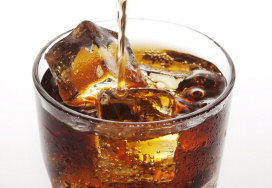
|
What is It?
Caramel coloring isn’t inherently dangerous if it’s cooked in the traditional
way of using sugar and water. Of course, most food manufacturers don’t use that
technique in the production of the coloring. The sugar is generally treated with
ammonia, which produces carcinogens.
Where is it Found?
The coloring is generally found in a variety of soft drinks.
Why You Should Avoid It
Given the popularity of soft drinks, the Center for Science in the Public
Interest once released a warning that caramel coloring could account for
approximately 15,000 cancers in the U.S. annually.
14) Hydrolyzed
Vegetable Protein
|
Hydrolyzed Vegetable Protein is a Common
Additive in Many Dips and Dressings:
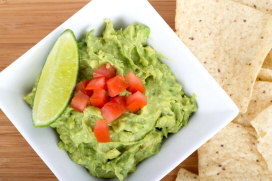
|
What is It?
Hydrolyzed vegetable protein is utilized to enhance flavor. It’s derived from
the protein of plants after it is reduced to amino acids. One such acid is
glutamic acid, which can release free glutamate.
Where is it Found?
Hydrolyzed vegetable protein is commonly used in sauces, soups, stews, gravies
and a number of meat products. It may also be used in potato chips, dips and
pretzels.
Why You Should Avoid It
When glutamate combines with sodium in your body, monosodium glutamate (MSG) is
formed. MSG has been long associated with such adverse reactions as nausea,
headaches and weakness. While food producers are required by the FDA to disclose
when MSG is added to a product, they don’t have to make the disclosure if MSG is
created as a byproduct from hydrolyzed protein.
13) Propyl
gallate
|
Ready to Eat Foods Commonly Contain
Propyl gallate:
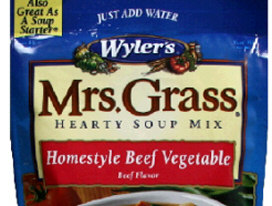
|
What is It?
Propyl gallate is an antioxidant preservative used to keep oils and fats from
losing color or flavor as the result of oxidation.
Where is it Found?
Propyl gallate can be found in meat products, chicken soup bases, a number of
vegetable oils, chewing gum and potato sticks.
Why You Should Avoid It
Studies have detailed a possible association between the preservative and cancer
in rats and mice.
12) Butylated
hydroxytoluene (BHT)
|
Turkey Bacon Contains BHT:
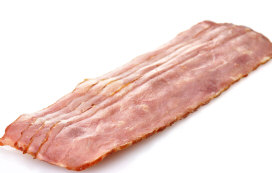
|
What is It?
Butylated hydroxytoluene, better known as BHT, is used to prevent meats from
spoiling.
Where is it Found?
BHT is commonly found in gum, cereals, chips, and vegetable oil. It is also used
in the packaging of food to retain freshness.
Why You Should Avoid It
While some studies have found it to be safe, others link BHT to cancers in mice,
rats and hamsters.
11) Indigotine/Artificial
Blue 2
|
Some Canned Pet
Foods Contain
Artificial Blue 2:
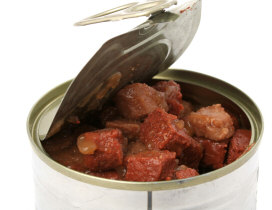
|
What is It?
Indigotine, otherwise known as Artificial Blue 2, is an artificial coloring.
Where is it Found?
Artificial Blue 2 can be found in candies, drinks and pet foods.
Why You Should Avoid It
The most comprehensive study conducted on the additive found evidence that it
may have triggered tumors in the brains of male mice.
10) Sucralose
|
Many Sugar Free Maple Syrups Contain
Sucralose:
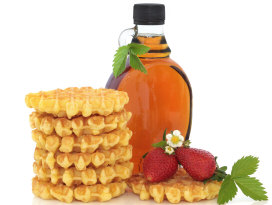
|
What is It?
Sucralose is an artificial additive produced by chlorinating sugar.
Where is it Found?
Sucralose is generally used in “healthy” alternatives for sugary food products.
Why You Should Avoid It
Manufacturers claim that the chlorine in sucralose is the same as that found in
table salt. However, tests have found that the chemical structure of the
chlorine in sucralose is essentially the same as that of the banned pesticide
DDT. Common effects of sucralose include muscle aches and headaches, diarrhea,
stomach cramps, bladder discomfort, dizziness and skin irritation. There are
also concerns regarding the effects sucralose has on immune system functioning
as well as the kidneys and liver. A study at Duke University discovered that
sucralose affects intestinal health, specifically the bacteria that is crucial
for digestion. The efficacy of prescription drugs may also be impacted when they
are combined with the substance.
9)
Erythrosine/Artificial Red 3
|
Erythrosine is Commonly Used to Die
Maraschino Cherries:
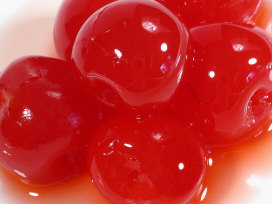
|
What is It?
Erythrosine, otherwise known as Artificial Red 3, is a food coloring.
Where is it Found?
Artificial Red 3 is commonly found in candies, baked goods and cherries in fruit
cocktails.
Why You Should Avoid It
During the 1980s, the FDA issued a recommendation that the dye be prohibited.
This came after a number of studies found evidence that, when tested on rats,
Artificial Red 3 caused thyroid tumors. However, despite the FDA’s warning and
suggestions to the contrary, the dye is still widely used throughout the world.
8) Butylated
hydroxyanisole (BHA)
|
BHA Is Commonly Used for Flavoring In
Crackers:
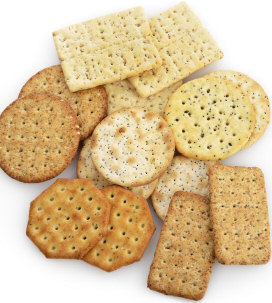
|
What is It?
Butylated hydroxyanisole, better known as BHA, is a preservative utilized to
prevent rancidity in foods that contain oil.
Where is it Found?
BHA is commonly found in gum, chips, breakfast cereals and vegetable oils. It is
sometimes utilized in the packaging of some foods in order to retain freshness.
Why You Should Avoid It
BHA has been shown in lab hamsters, rats and mice to cause cancer. The reason it
is deemed “safe” for human consumption by the FDA is because all the cancers
that developed in the rodents did so in their forestomachs, which is an organ
human beings don’t possess. Therefore, BHA is considered a “safe” additive.
However, despite this endorsement, a study, which was published in the ‘Japanese
Journal of Cancer Research,’ found that BHA, from reasonable speculations, was
carcinogenic.
7) Parabens
|
Parabens Are Commonly In Cosmetics:

|
What is It?
Parabens are synthetic preservatives, which are used to prevent mold from
developing on yeast-based food
Where are They Found?
Parabens are commonly used in a variety of breads.
Why You Should Avoid It
According to research, parabens can disturb an individual’s balance of hormones.
A study published in ‘Food Chemical Toxicology’ discovered that a daily intake
of parabens hindered the production of testosterone and sperm in lab rats.
Parabens have also been discovered in cancerous breast tissue.
6) Partially
Hydrogenated Oil
|
Trans-fat in French
Fries:
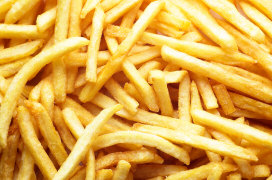
|
What is It?
Partially Hydrogenated Oil is a processed fat that enhances a product’s
shelf-life.
Where is it Found?
The trans-fat product is found in a wide range of foods that are processed,
especially deep-friend foods, margarines, shortening, baked goods, cookies and
snack foods. While a number of food manufacturers have adopted the use of
alternatives, it’s still important for you to check the labels.
Why You Should Avoid It
The FDA allows food manufacturers to claim that their product does not contain
trans fat as long as the product has under a half gram (0.49 grams) of trans
fat. On paper, that doesn’t sound too bad. However, when one factors in that an
individual should only consume, at the most, two grams of trans fat a day,
consumption of supposedly ”trans fat-free” food can take a toll on one’s health.
A listing of “partially hydrogenated oil” on the product’s ingredients can
quickly determine if something is indeed trans fat-free.
5) Sodium Nitrite
|
Many Canned Meats Contain Sodium Nitrate:
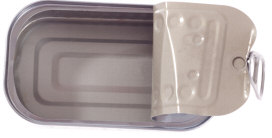
|
What is It?
Nitrites and nitrates neutralize bacteria that can cause botulism and also
retain the coloring of meat.
Where is it Found?
Sodium nitrite is commonly found in bacon, lunch meat, hot dogs and a variety
of processed meat products.
Why You Should Avoid It
When nitrite is consumed it can combine with amino acids and produce
nitrosamines, which are strong carcinogenic compounds. There’s an increased risk
when you eat bacon. Ascorbic acid or erythorbic acids are safe alternatives in
bacon products.
4) Acesulfame-potassium/acesulfame-K
|
Acesulfame-K is Often Mixed With Other
Natural As Well As Artificial Sweeteners:
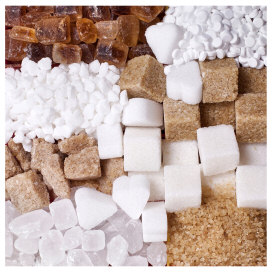
|
What is It?
Acesulfame-potassium, otherwise known as acesulfame-K, is an artificial
sweetener and is about 200 times sweeter than sugar.
Where is it Found?
Acesulfame-potassium is found in chewing gum, baked goods, soft drinks,
gelatin desserts and energy drinks.
Why You Should Avoid It
While a number of studies have concluded that acesulfame-potassium is safe,
two separate studies found that the additive may cause cancer. That’s because
the substance can break down into acetoacetamide, which is a substance that has
been found to affect the thyroid of rabbits, rats and dogs when taken in large
quantities.
3) Saccharin
|
Many Diet Sodas Contain this Harmful
Ingredient:

|
What is It?
Saccharin is a sweetener with a sulfa base that is primarily made up of
benzoic sulfimide.
Where is it Found?
Saccharin is commonly used in the diet as a “healthy” alternative to sugary
products.
Why You Should Avoid It
Common reactions to saccharin can include diarrhea, nausea and skin issues.
Although the FDA does not consider it to be a carcinogen, there are concerns as
saccharin has been linked to bladder cancer in rats. To-date, there are no solid
links to bladder cancer in humans, though there are concerns.
2) Brominated Vegetable Oil
|
Sodas Including Mountain Dew and Energy
Drinks Like Gatorade Contain BVG:
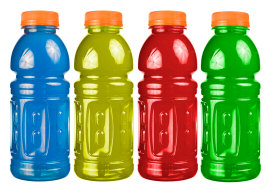
|
What is It?
Brominated Vegetable oil (BVO) has the element bromine added to it to
increase the density of the oil. Food manufacturers generally prefer it over
regular vegetable oil, as it prevents oil from floating to the top of the
product.
Where is it Found?
BVO is commonly found in soft drinks.
Why You Should Avoid It
Bromine can affect the function of the thyroid. Animal studies, have found
that BVO consumption results in heart and kidney damage as well as increases fat
deposits in these organs. In extreme instances, BVO resulted in stunted growth,
testicular damage and produced lethargy and fatigue.
1) Azodicarbonamide
|
Azodicarbonamide is Often Contained in
Baked Goods:

|
What is It?
Azodicarbonamide, otherwise known as ADA, is another type of Bromide.
Where is it Found?
ADA is commonly used in bread as a flour-bleaching agent, and in beer and a
variety of fast food products.
Why You Should Avoid It
ADA has been linked with obesity, and has been connected with asthma.
Furthermore, there is some speculation that the substance may cause cancer and
brain disorders. While the use of Azodicarbonamide is illegal in Europe and
Australia, it’s legal in the U.S.
Conclusion
With authorities endorsing certain additives and scientists warning against
their use, it’s difficult to know what is and isn’t safe to consume. Further
muddying the waters is the fact that additives often have alternative names or
food manufacturers do not have to legally list some of the substances in their
products. Ultimately, your best chance at eating healthy and avoiding the
inherent risks associated with additives is to educate yourself on the subject
as much as possible, and eat a more natural diet free of as many processed foods
as possible.
Diet & Nutrition
Top Lists:
Top 15 Foods That Help Migraines
24 Food Additives That You Should Consider Avoiding
Top 15 Healthy Spices From India
15 Disgusting Ingredients In Your Food
15 Best Foods For Brain Health
15 Foods That Are Surprisingly Good for You
Top 15 Organic Produce That's Better Than Conventional
15 Weird Interesting Facts About Vegetables
10 Best Cleansing & Detoxifying Foods
Informational:
Evaluating Diet Plans: Which One is Right for You?
The Essential Health Benefits of Ginger
The Health Benefits of Kale
Top Natural Appetite Suppressants That Will Help You Lose Weight
Almond: The Magic Pill For Hunger, Weight Loss and Cholesterol
How Effective is Phen375 in Losing Fat?
What Are Health and Losing Weight Benefits of Unique Hoodia?
Organic Foods – Are they better than Conventional Foods?
Facts about Alcohol
Best Ways to Get a Good Night’s Sleep
General Benefits of Green Tea
Health Benefits of Inositol Supplements
Anti-Aging Foods to Stay Young
Who is Responsible For Overweight Children?
My Secret to Losing 100 Pounds in 6 Months
How and When to Use HCA Extract? |